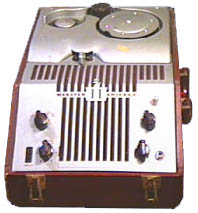By 1946, tape recorders were already well-known in the audio engineering communities in the U.S., the UK, and elsewhere, but few of them were actually in use. Between about 1948 and 1950, high quality studio recorders would enter the scene and begin to displace the disc “transcription” recorder for many applications. For a brief moment, there seemed to be an opportunity for high-fidelity wire recorders to enter this market, too.

Magnecord model SD-1
Several former Armour Research Foundation employees formed the Magnecord Corporation in 1946. Their first product was to the Magnecorder model SD-1 wire recorder, a high fidelity machine intended for the studio. According to one of Magnecord’s founders, SD stood for “super duper.” It was capable of true high fidelity reproduction, although by the time it was demonstrated the shift to tape recorder was underway. While the SD-1 failed, Magnecord became one of the leading manufacturers of tape recorders.
The peak of the wire recorder’s short commercial life came in 1948 and 1949. Many Armour-based wire recorders began to appear on the American market under various brand names, such as Webster-Chicago (or Webcor), Silvertone, Air King, WiRecorder, Crescent, Miles Reproducer, Pentron, Bendix Radio, C. G. Conn, J. P. Seeburg Corp., Sonora Radio, Stromberg-Carlson Wilcox-Gay, Hoffman Radio Corp., RCA, GE, and Electronic Sound Engineering Co. The novelty of the technology and the ability to record sound at home spurred a great deal of interest. Webster-Chicago Corporation also hit upon an important market niche with its line of wire recorder dictation machines. Although they lacked some of the features of products made by Dictaphone or Thomas A. Edison, Inc., they were less than half the price.

Webster Chicago model 80
The wire recorder’s image as a technologically advanced gadget was evident in popular culture. Arthur Miller’s play, Death of a Salesman, featured a scene where the protagonist’s boss is so fascinated with the recorder that he can’t concentrate on a conversation. However, the image would soon fade.